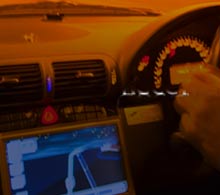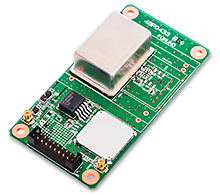Articles for ITS market ”Using a smartphone while driving” and “Level 3 automated driving”
”Using a smartphone while driving”, severe punishment and driver awareness
HMI is short for Human Machine Interface.
HMI in the automotive field often refers to the screen in the vehicle. In other words, emphasis is placed on human-car vision interfaces.
Under these circumstances issues that require fundamental discussions about ideal forms of HMI have emerged.
One issue is “using a smartphone while driving”, or operating your smartphone while driving.
The other is "secondary activity" in level 3 automated driving.
On December 1, 2019, the revised Road Traffic Law was enacted for “using a smartphone while driving” and penalties were tightened. Specifically, just holding a smartphone in your hand results in a jail sentence.
In addition, the number of violations in the event of an accident caused by “using a smartphone while driving” has tripled to six points and is subject to administrative license suspension.
However, when observing driving situations in the city after the law was amended we still see many people driving while using smartphones. In many cases they seem to be using social networking services such as LINE, Facebook, Twitter, email and games.
These situations are not only observed in Japan, but all over the world. There seems to be a very low individual awareness that they are doing dangerous acts that are punishable by law.
Why CarPlay and Android Auto aren't popular
What do smartphone planners and manufacturers think about control by “using a smartphone while driving”?
Technically, Apple's CarPlay and Google's Android Auto which link the in-vehicle device and smartphone were mass-produced around 2015. The number of vehicles equipped with these technologies in North America has gradually been expanding. Along with this, “using a smartphone while driving” is on the decline, especially among younger generations. However, for cars manufactured before 2015 that support CarPlay and Android Auto, the "using a smartphone while driving" situations are routinely still the same and performed by all generations.
Actually in Japan the name CarPlay and Android Auto are not recognized at all.
There are fewer cars in Japan than in North America that can support CarPlay and Android Auto. But the reason is much different.
In Japan, car navigation systems became popular more than five years ago in the 1990s, compared to Europe and the United States. In-vehicle devices including the world's most advanced car navigation functions were mass-produced by Japanese manufacturers one after another. As a result, Japanese car navigation manufacturers were not aggressive in introducing CarPlay and Android Auto, which use the in-vehicle device as a "simple HMI."
However, automakers including Toyota's DCM (Data Communication Module), have begun to mass-produce connectivity technology R & D by circumventing car navigation manufacturers. Following Mazda Connect of Mazda, Toyota also introduced a display audio in the Corolla released in September 2019 with a common HMI. It is certain that this will be expanded to all Toyota models in the future.
With the business policies of automakers and car navigation manufacturers not being unified, the younger generation seems to feel that smartphones are easier to handle. After all, smartphones are more natural for them as an HMI.
Discussion is needed between "using smartphone" and "automated driving" when considering human intervention.
"Using a smartphone while driving" is strictly prohibited, after revising the Road Traffic Law. However "using a smartphone while driving" is allowed under the same road traffic law for automated driving cars at level 3 and above.
There are five levels of automated driving, 1 to 5. In levels 1 and 2, driving is mainly performed by humans. In levels 3 to 5 the vehicle is the main driver.
At level 3 when the system determines that automated driving cannot be continued, such as in an emergency the system issues a TOR (Take Over Request) to the driver through voice, display, vibration, etc.
Until a TOR occurs the driver can perform actions other than driving without gazing forward, while maintaining a posture capable of returning to driving. This is called a secondary activity.
Secondary activities allow for eating and drinking, reading, and even smartphone operation. Therefore "driving while using a smartphone" is acceptable.
I've talked with carmakers and government agencies in various discussions about the challenges of introducing level 3 automated driving into society. In fact, I have driven on public roads with several level 3 automated driving test vehicles.
Based on such experience I believe that mass production of level 3 vehicles is extremely difficult from the perspective of social acceptability.
In mid-December 2019 there were reports that Honda will mass-produce level 3 automated vehicles for highway traffic congestion by the summer of 2020. “The wealthy people who can buy Level 3 self-driving cars can use smartphones "It is unfair to say that ordinary people who continue to drive older cars like us are not allowed to use smartphones.” These are some comments I sometimes see on the internet.
I agree with these opinions.
The relationship between “people and society” may change significantly due to automated driving and connectivity through communication. That is why it is necessary to discuss technology and law where people are prioritized, not technology.
I think society as a whole needs to think more deeply about the mismatch in HMI thinking between "using a smartphone while driving " and "level 3 automated driving".
Writer introduction

Mr. Kenji Momota Automotive journalist
His major is the world automotive industry and he is also familiar with the energy industry, IT and the aging society problem as the related fields. He acts around the world based in Japan and USA and writes for the general magazines, the technology journals and the automotive related media etc.
He is also commentator of motor race and world's motor show on TV program based on his career of the driver of Indy Racing League and NASCAR. In recent years, he has been covering about a paradigm shift from developed countries to developing countries, the motorized vehicle like EV and the telematics.
FURUNO ITS Journal
Click here for the latest articles after 2022 (in Japanese)2022
- The "realistic" self-driving roadmap shown by the Japanese government and a hands-on report on the latest Subaru EyeSight X
- Will FCVs (Fuel Cell Vehicles) Become Popular? ~New Movement in Toyota and Honda~
- The 'Complete' online sales of new cars start in Japan. Will this new way of buying cars take root?
- Many Firsts! On-Site Report from Tokyo Auto Salon 2022 - The author, who knows what goes on behind the scenes, looks back on 40 years of history. -
2021
- "Moving toward zero traffic fatalities for four-wheeled and two-wheeled vehicles globally in 2050" ~Experience on Honda's latest safety technologies~
- Tsuneishi Shipbuilding's building and DX, an exclusive visit to the main factory
- Japan's Smart City: New Moves toward Practical Use
- When will self-driving buses (service cars) be put to "full-scale" practical use?
- Utilization vehicle data during disasters
- Toyota-led Connected Technology to Transform Commercial Vehicle Business -From light trucks to large trucks and buses-
- Toyota enters the connected car "Personalization" business
- Japanese automakers' carbon-neutral strategies swept up in ESG investment
- Drive experience of the latest autonomous vehicle models and advanced driving support systems
- Will carbon neutrality accelerate the trend to strengthen LCA (Life Cycle Assessment)?
- Semiconductor shortage exposes realities of the automotive industry
- Online Autonomous Driving Contest Enhancing development of Human Resources
2020
- What happens to CASE when gas cars are banned in Japan?
- When will Flying Cars be launched?
- Expectation vs. reality:Autonomous Driving in Japan
- V2X, Becoming increasingly important in autonomous driving
- Technology of Subaru “EyeSight X”
- Lifestyle-oriented French cars gain popularity in Japan
- Human-oriented smart cities are wanted
- MaaS and CASE, how would automotive industry change after COVID-19?
- The beginning of virtualization era, triggered by COVID-19
- Trend of EV shift and consumer demands
- TOYOTA Press conference about ADAS - Releasing algorithm for "sudden acceleration suppression during attempted sudden acceleration" free of charge -
- The Japanese automotive industry in 2020 - 3 turning points -
- "Using a smartphone while driving" and "Level 3 automated driving"
2019
- Motor show business model is at a turning point - Tokyo Motor Show Report -
- Commercialization and monetization of MaaS - ITS World Congress Singapore Report -
- Android Automotive pays attention to V2X - Report from the Frankfurt Motor Show 2019 in Germany -
- Automobile Distribution Revolution and DCM (Data Communication Module)
- Connected business potential and newly proposed "eMaaS" by Honda
- 5G services for practical use are multiplying
- Connectivity technologies attracting attention due to frequent traffic accidents
- Shanghai Motor Show report -SUV, EV, Automated car & 5G-
- Drone Business roadmap and updates to Michibiki (Quasi-Zenith Satellite System)
- MaaS (Mobility as a Service) "town development." Full-scale promotion for a national project
- CES organizer states "Data Period in 2020s." Transformation of the Automotive Industry in CES, US "-CES2019 Report-"
- "Return to Origin" directed towards the age of change, automatic operation and connectivity
2018
- New proposal for Private Car Automated Driving Level and other Hot 5G Technology Topics
- Standardized EV charging infrastructure concerns in Europe, US, Japan and China - Kobe EVS 31 field report -
- Touring a pure car carrier and a test drive of the latest hybrid car
- Planning stage products are exhibited at the newly established visualized mobility service "TOYOTA MOBILITY SHOWROOM".
- Potential “Community Car-share” program promoted by local residents
- CES Asia Report 2108
- Companies attempt new Vehicle-to-Infrastructure communications, including traffic volume measurements and vehicle positioning. -ITS Asia Pacific Forum in Fukuoka-
- Geneva show in Switzerland. Flying cars and MaaS (Mobility as a Service) were hot topics.
- EV (Electric Vehicle) proposals by country
- MaaS competition through service mobilization, M & A and technical field collaboration is accelerating. - The CES 2018 Report -
2017
- Big data’s initiative and fight for the automotive industry. Cooperation among companies becomes increasingly important.
- Connected car and road-to-vehicle communication automatic operation
- ETC (Electronic Toll Collection) and ETC2.0. Current situation and projected future
- Rapid development of sharing economy
- Germany is first to recognize level 3 automated driving
- ITS EU 2017 Field Reports -Automatic Operation and the eCall-
- From Infotainment to ITS, the competitive area is spreading in the car big data industry.
- GTC (GPU Technology Conference) Report and the de facto standardization of AI (artificial intelligence)
- Renesas' new challenge! "e-AI Solution" and "Renesas Autonomy"
- The Automobile industry is shifting from a manufacturing industry to a service industry.
- The movement toward accident countermeasures for aging drivers in Japan
- Fusion of ride sharing and fully automated driving is advancing in the USA.
2016
- Overview of the Quasi-Zenith Satellite System (QZSS) and advancements toward full-scale practical use including the Tokyo Olympic Games - G-space EXPO 2016 report-
- Japan’s automated driving project "SIP-adus" will be a large demonstration experiment.
- The International Home Care & Rehabilitation Exhibition. There were many car manufactures with exhibits booths at this show.
- Japanese car manufacturers starting to concentrate on strengthening the ADAS system
- A new movement of legislation for autonomous cars
- Cyber Security and “AGL”, the new OS for automotive are hot topics in the connected car industry
- “High precision 3D map” the key future of autonomous car and pedestrian dead reckoning
- Chinese “BAT” is accelerating their business in the EV (Electric Vehicle) market
- Tesla's original connection to Taiwan and the new transportation system technologies.
- "The main topic" of the Geneva Motor Show was how to strengthen "pedestrian protection"
- The probe data business is getting more competitive
- Reporting directly from the 2016 CES show "Data services will soon become the main revenue source of automotive industry"
2015
- Do the automated driving systems need the GNSS (Global Navigation Satellite System) ?
- ETC Version 2.0 is coming soon. A new service was announced at the Tokyo Motor Show and the possibility that is could be used as a device for older drivers.
- "Connected Horizon" and "eHorizon". Germany's leading parts supplier accelerates strengthening of "Big Data" for business



 Inside the new Toyota Corolla. Comparison of car navigation system and iPhone navigation function
Inside the new Toyota Corolla. Comparison of car navigation system and iPhone navigation function Press release at the new Toyota Yaris (formerly Vitz)
Press release at the new Toyota Yaris (formerly Vitz) Daihatsu new Rocky’s interior
Daihatsu new Rocky’s interior GPS/GNSS Receiver&Chips and Modules (positioning and timing)
GPS/GNSS Receiver&Chips and Modules (positioning and timing)